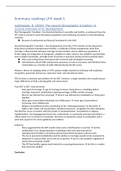Summary readings LFH week 1
Lesthaeghe, R. (2014). The second demographic transition: A
concise overview of its development.
First Demographic Transition = the historical declines in mortality and fertility, as witnessed from the
18th century onward in several European populations and continuing at present in most developing
countries.
Because of sentimental and financial investment in the child
Second Demographic Transition = new developments from the 1970s onward can be expected to
bring about sustained subreplacement fertility, a multitude of living arrangements other than
marriage, a disconnection between marriage and procreation, and no stationary population
further aging, the integration of immigrants, adaption to other cultures, less stability in partnerships,
more complex households, and high levels of poverty or exclusion among certain household types.
More overarching theory that spans both economic and sociological reasoning
Link between cultural shifts and dynamic processes of cohort succession and individual value
reorientation as a function of paths followed during the life course
Maslow’s theory of changing needs of 1954: greater weight attached to individual self-realization,
recognition, grassroots democracy, expressive work, and educational values.
FDT has been a necessary precondition for the SDT. However, a single transition view would obscure
major differences of both a demographic and social nature.
From FDT to SDT: reversal trends:
- Early ages of marriage age of marriage increases, living alone or cohabiting before
marriage, long-term cohabitation replacing marriage, fertility outside marriage
- Divorce was followed by remarriage divorce was followed by cohabitation or living apart
together
- Mean ages of parenthood declining, low childlessness mean ages of parenthood
increasing, more childlessness
- Religious and political factions contributed to the ‘embourgeoisement’ of the family
higher order needs: self-actualization, individual autonomy, recognition for their realization
The SDT thus occurs in tandem with the growth of ‘postmaterialism’ and political or religious
‘depillarization’, the disengagement from civic, professional, or community-oriented associations, a
critical stand vis-à-vis all forms of authority, the stress on expressive values in socialization and in
work and a quest for far more egalitarian sex relations.
Criticisms:
- Many suggested that the SDT would remain only in Northwestern countries but the
combination of (a) rising proportions cohabiting rather than marrying and (b)
subreplacement fertility is stretching outward beyond the European cultural realm.
- The rise in premarital cohabitation and the decline in marriages would not be connected to
ideational or cultural shifts, but to the rise of poverty but it is the wealthier segments of
society that premarital cohabit.
- The SDT low-fertility regime would merely be a passing phenomenon but this is a matter
that cannot be studied
Conclusion
, The bottom line with respect to the predictive capacity of the 1980s version of the SDT theory is that
it correctly anticipated:
- The unfolding of very different patterns of partnership formation
- The shift in value orientations in many spheres (ethics, politics, sex relations, education, etc.)
that emerged as central driving forces in childbearing decisions, and
- The emergence of subreplacement fertility as a structural and lasting feature
Zaidi, B., & Morgan, S. (2017). The second demographic transition
theory: A review and appraisal.
Second demographic transition = sustained subreplacement fertility, a multitude of living
arrangements other than marriage, the disconnection between marriage and procreation, and no
stationary population.
Cultural shift towards postmodern attitudes and norms, individuality and self-actualization
The SDT clings to a problematic developmental perspective and as an inevitable result is inconsistent
with important features of family and fertility in developed country contexts.
Principal demographic feature of SDT: birth decline below replacement.
Basic features of the SDT:
- The weakening of marriage as the only type of family structure, resulting from high divorce
rates and a rise in cohabitation
- Shift in family relations from king-child with parents to king-couple with child
- A shift from preventive contraception to self-fulfilling contraception
- The uniform family starts giving way to more pluralistic forms of families
From FDT shift in norms (altruistic to individualistic) SDT
Why SDT was different from FDT:
- Shift from king-child to king-couple from a child-oriented society towards a couple-
oriented society
- Maslowian drift and rise of individualism a shift toward higher-order needs of self-
actualization and individual autonomy to motivate behavior once the more basic needs such
as survival and safety have been satisfied
- Pushback against economic explanations ideational change (increase in individual
autonomy, secularization, female emancipation, postmaterialism) is the central explanation,
without which all other explanations are incomplete.
Lesthaeghe expands the geographic scope of the SDT by explaining changes in industrialized nations
more broadly, in the U.S., Canada, Australia, New Zealand and Japan.
Changes in union and family formation are consistent with the SDT expectations as well as with the
deinstitutionalization of marriage (Cherlin).
Failures of SDT:
- Failure to find consistent patterns between countries reversal of marriage rates, mean age
of marriage in some countries with low- and middle-income is the same as in wealthy
countries, variability in the weakening of marriage, variability in cohabitation, variability in
separation of fertility and marriage, difference in the replacement rate
- Failure to account within-country variation





